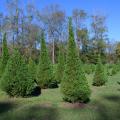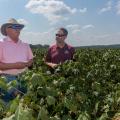Forest Management
Mississippi has about 18.5 million acres of forestland, which amounts to about 62 percent of the state's land area. Almost 70 percent of this forestland is owned by private, nonindustrial landowners, with more than 150,000 people owning 20 acres or more of forestland. Each landowner may have a different set of forest management objectives, so management decisions should be tailored to the needs of the landowner as well as the objectives and capability of the land.
Mississippi has highly productive forests because of good soils, a long growing season, and abundant rainfall. These highly productive forests, combined with recent increases in timber prices and a high percentage of private ownership, result in forestland ownership being a significant family asset. Mississippi's forests are funding children's college education, providing for people in their old age, and enabling a lifestyle many would not have had otherwise.
A key to successful forest management is a written management plan in which landowners define their management objectives, inventory their current forest resources, and plan activities to accomplish objectives consistent with existing resources. The management plan, once developed, should be followed unless conditions warrant changes. Thus, a management plan is a "living" document that landowners are constantly developing, implementing, reviewing, and revising with appropriate professional advice.
Forest management in Mississippi is complex due to diverse forest types, different ownership objectives, tract histories, and other factors. Forest Management includes the following:
Frequently Asked Questions
How does the study of Forest Genetics improve tree species?
Is planting pine trees on idle fields a good investment?
Is replanting after timber harvest a good investment?
Publications
News
Landowners working to improve game bird habitat can sign up for Feb. 28 and March 1 weekend events that provide practical information for property management.
The Mississippi State University Extension Service is hosting the turkey and quail management social and workshop in Shannon, Mississippi.
RAYMOND, Miss. -- Mississippians who want to deck their holiday halls with a locally grown Christmas tree will have no problem finding one. Although weather conditions have tested the state’s growers over the last two years, tree inventory is strong.
RAYMOND, Miss. -- Forest landowners who incurred damage from last year’s drought now have more information about the federal cost shares for restoration assistance approved in April. The Emergency Forest Restoration Program, or EFRP, is open to landowners in all 82 counties with private, nonindustrial property in rural areas who have lost pine trees related to pine bark beetle infestations that stemmed from last year’s drought.
Success Stories
Gaddis & McLaurin might sound more like the name of a law firm than a general store, but the name is synonymous with all manner of dry goods in the Hinds County community of Bolton and has been since the 1870s.
In an industry where every piece of equipment can seriously hurt the operators and crew, one Mississippi logging company has not recorded an accident during more than 40 years of operation, from Brandon to Gulfport.
Drew Sullivan admits his first timber tract would not have fetched an appraiser’s attention, but he usually drove back home from a lumber yard in Kemper County each week with around $150 in his pocket— not bad for a 15-year-old Mississippi boy growing up in the mid-90s.






